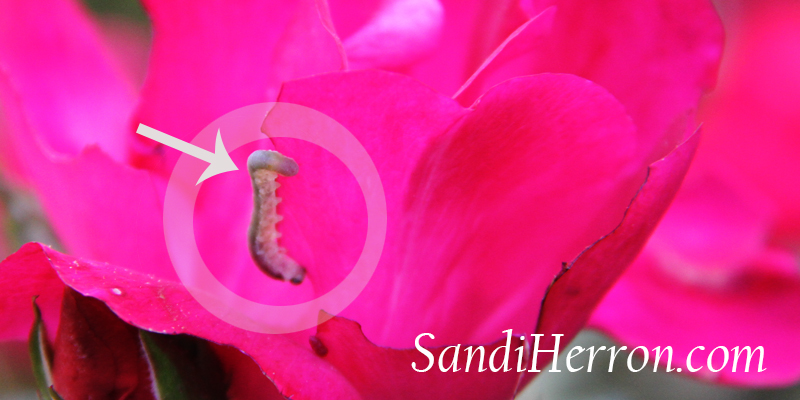
Sawfly Larvae |SandiHerron.com, Life at Spring Meadows
Sawfly Larvae Love Your Roses!
Roses are a beautiful addition to the garden. Their scent brings back memories of childhood days for many of us. But with all their beauty, roses seems to attract the most pests and damaging insects of any of my garden plants. One of the first challenges I notice each year is the Sawfly Larvae.
Sawfly Larvae in the Springtime
In the spring, Sawflies (insect of the wasp family) make their appearance in late April or early May, before the Japanese Beetles. The sawfly larvae (resembles green worms) is what does the damage. They will not kill a rosebush if detected early, but they will, however, turn your beautiful plant into a skeleton almost overnight. You will find the leaves have been devoured, leaving behind veins and stems. Early detection is your best line of defense, so grab that cup of coffee and take a morning stroll, checking your plants for pests and diseases. Pay close attention to new leaves, buds, and the underside of the leaves where you will often see the first signs of a threat.
According to Wikipedia, some larvae look like caterpillars (the larvae of moths and butterflies), with some notable differences; (1) they have six or more pairs of prolegs (sometimes greatly reduced and difficult to see) on the abdomen, while caterpillars have five pairs or fewer, (2) they have two stemmata instead of a caterpillar’s six, (3) caterpillars (except for a tiny minority) always have the two first abdominal segments legless, and (4) sawfly larvae have an invariably smooth head capsule with no cleavage lines, while lepidopterous caterpillars bear an inverted “Y” or “V” (adfrontal suture). Typical sawfly larvae are herbivorous, the group feeding on a wide range of plants. Individual species, however, are often quite specific in their choice of plants used for food. The larvae of various species exhibit leaf-mining, leaf “rolling”, or gall formation. Three families are strictly xylophagous, and called “wood wasps“, and one family is parasitic. The larvae that do not feed externally on plants are grub-like, without prolegs. When harassed, many sawfly larvae are able to squirt a foul liquid from their last segment. Excerpt from Wikipedia Read the full article on Wikipedia
How To Treat Roses Infected with Sawfly Larvae
My first choice of ridding the plant of the sawfly larvae is handpicking and destroying, one by one. I take an empty water bottle on my morning walks and if I see any of the sawfly, they go into the bottle and then thrown away. My goal is to rid my garden of the pest, so knocking them off the leaves and onto the ground is not an option. Also, encouraging beneficial insects in your garden, such as green lacewings and ladybugs, is a priority. Place bird feeders near the roses to draw birds such as the Chickadees, who will eat the sawfly larvae. Using these natural methods to destroy instead of spraying with chemicals will protect the beneficial insects, birds, and pollinating bees from harmful chemicals found in sprays.
Resources: Wikipedia contributors. “Sawfly.” Wikipedia, The Free Encyclopedia. Wikipedia, The Free Encyclopedia, 20 Aug. 2015. Web. 25 Aug. 2015.
Discover more from Sandi Herron - Life at Spring Meadows
Subscribe to get the latest posts sent to your email.






Thank you for the this helpful information! I plan to investigate my roses.